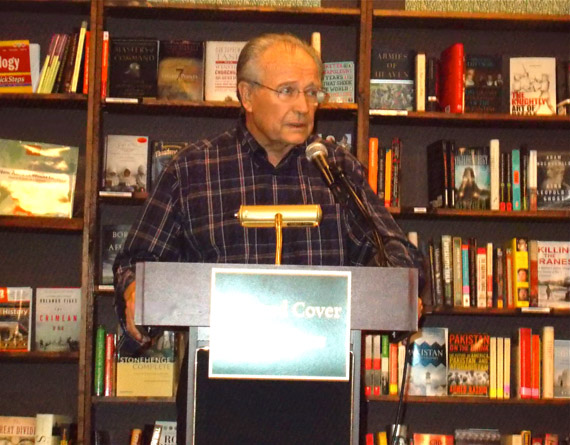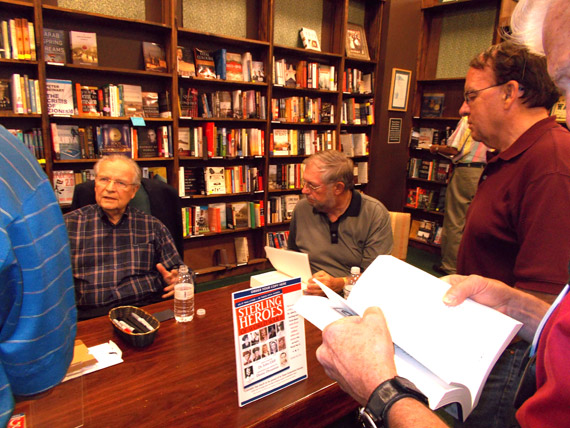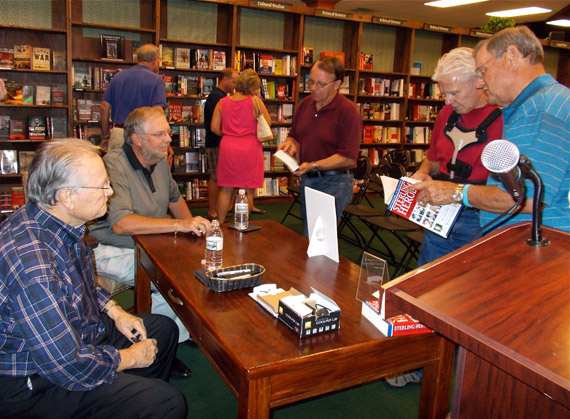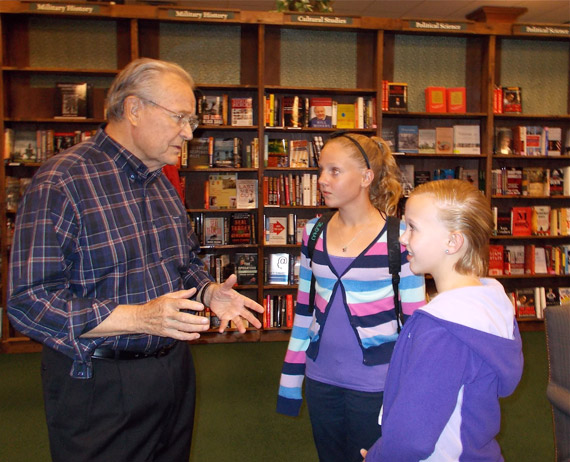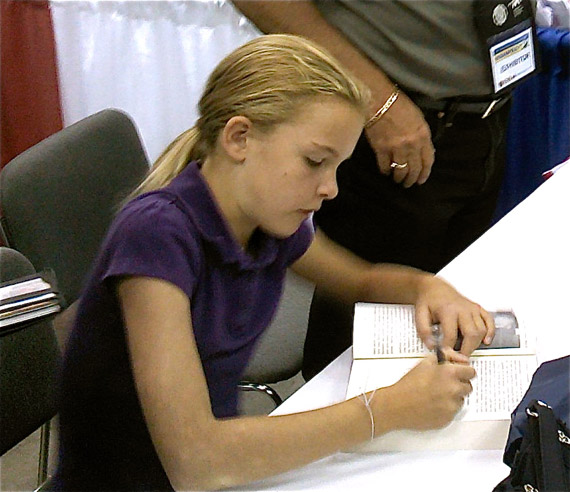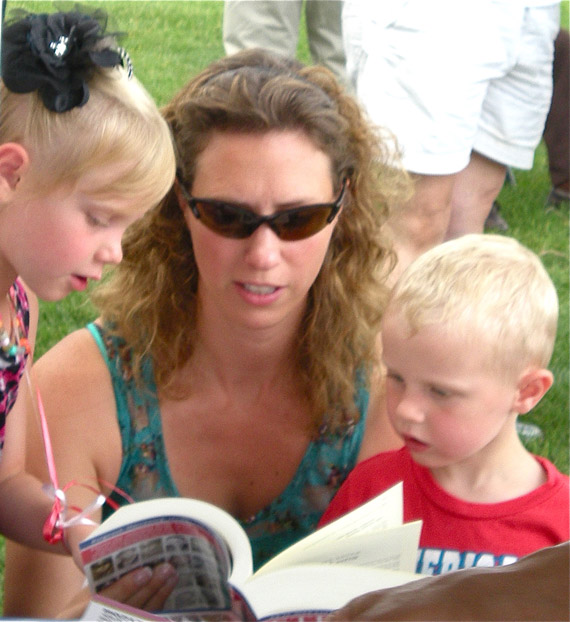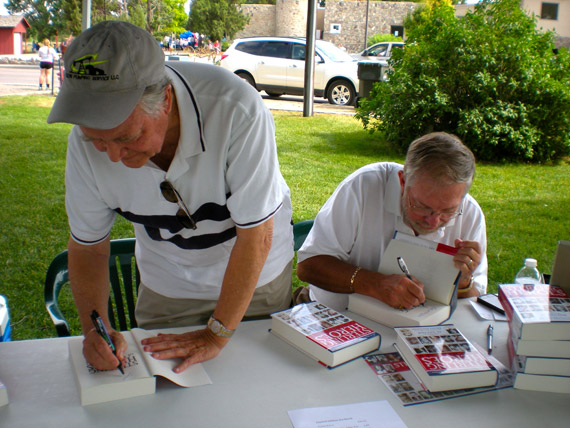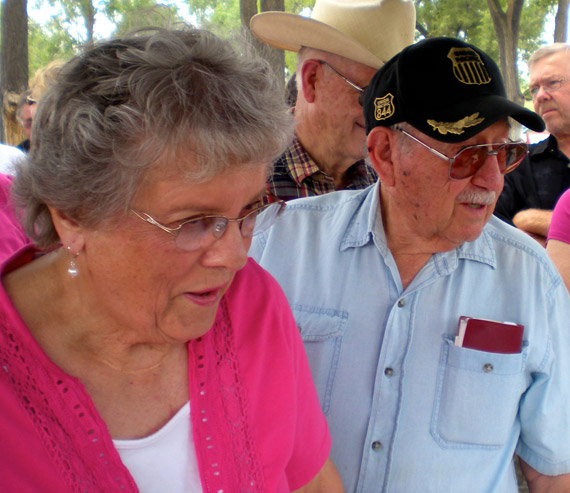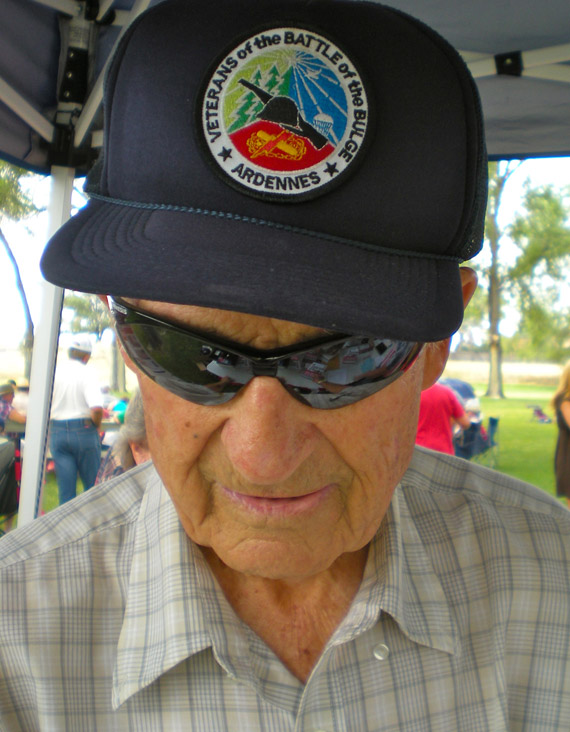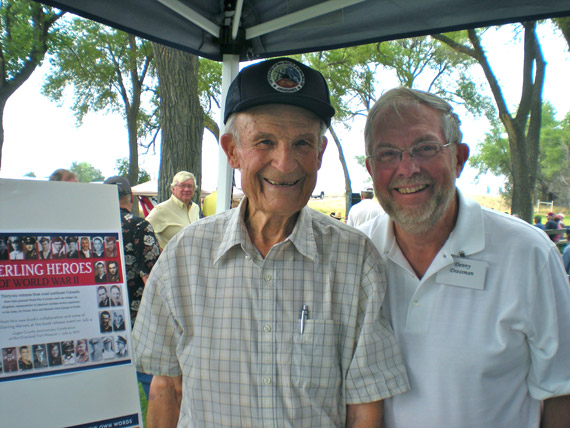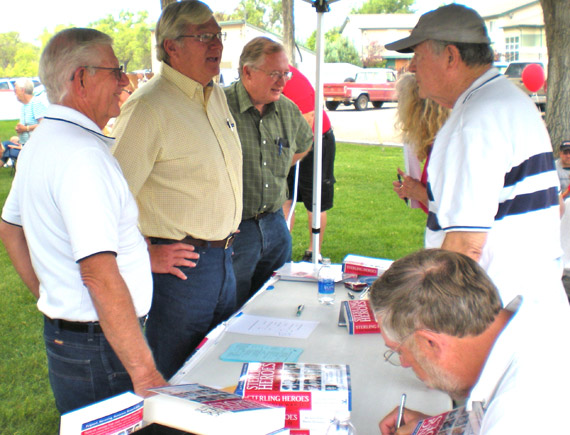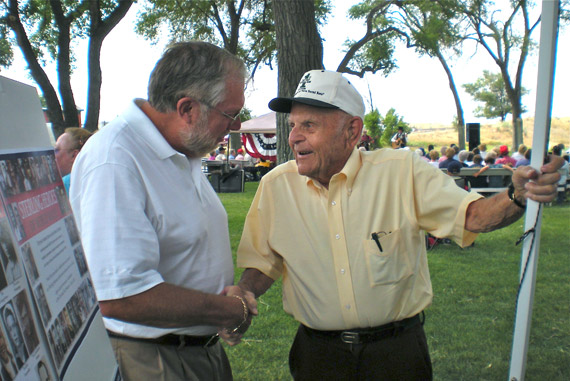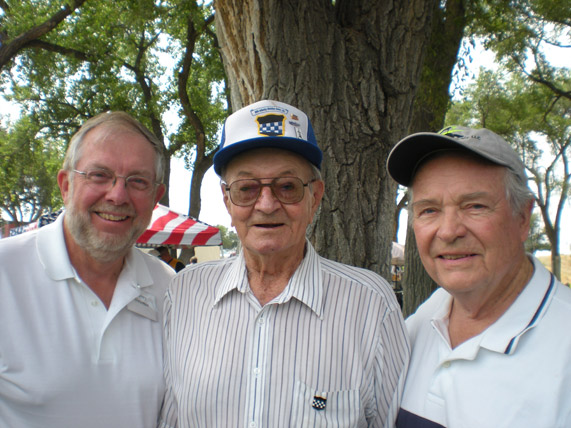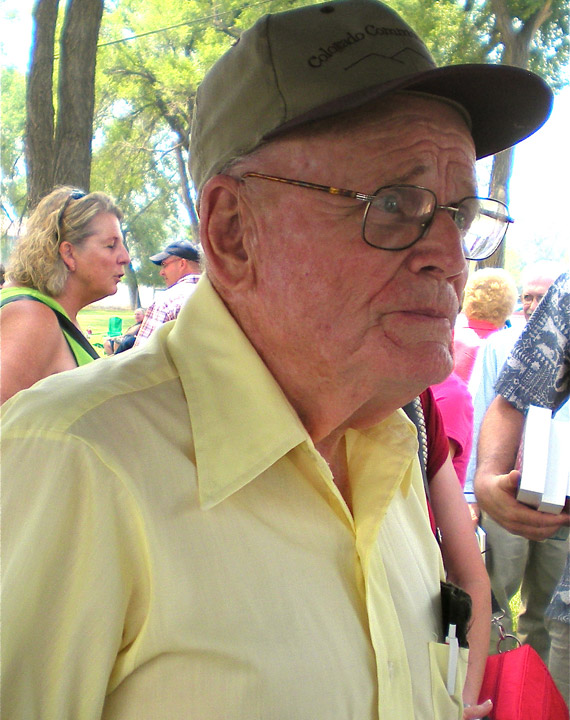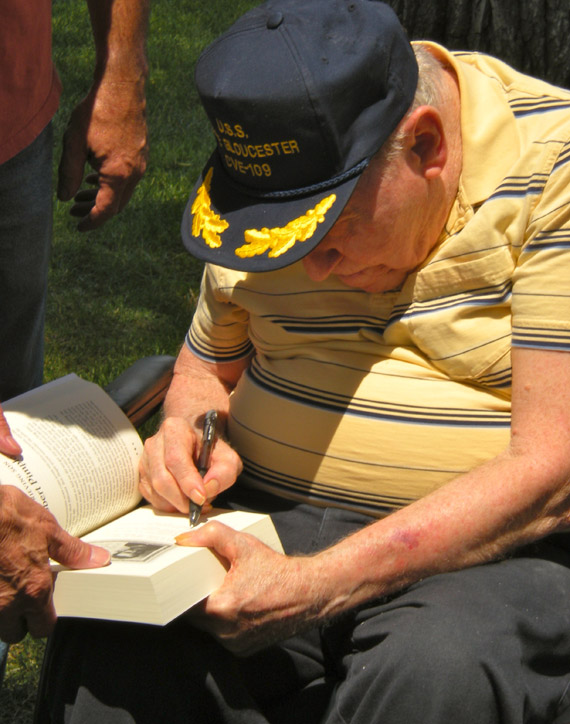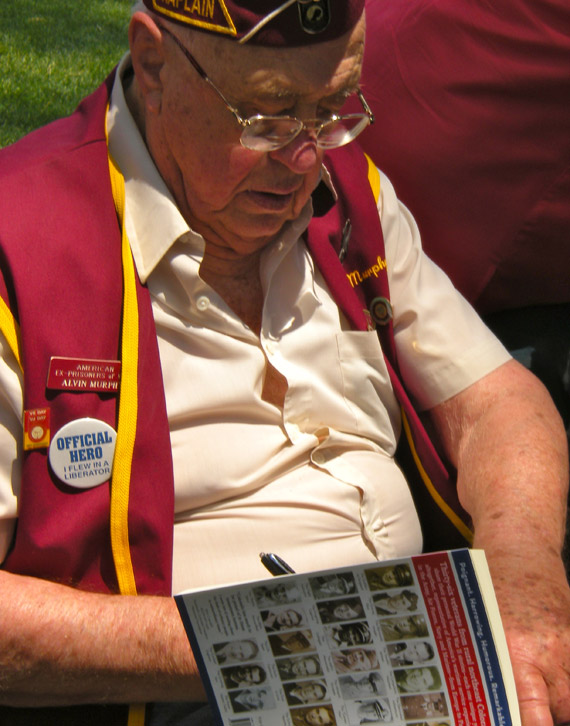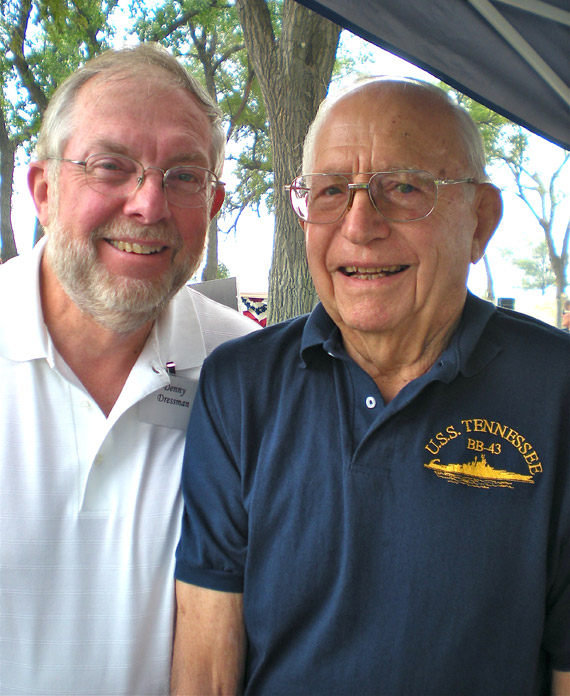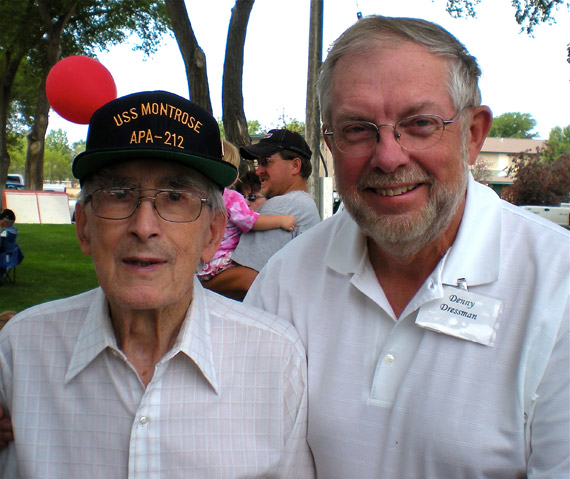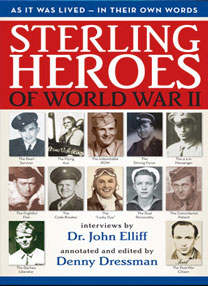
Poignant. Harrowing. Humorous. Remarkable.
Meet The Flying Ace, The Intrepid Escapee, The Pearl Survivor, The Dachau Liberator and dozens more Sterling Heroes as thirty-six veterans from rural northeast Colorado share their personal World War II stories—each one unique yet, altogether, representative of America’s wartime service experience, in the Army, Air Forces, Navy and Marines—from Europe to the Aleutians and across the Pacific.Purchase Book
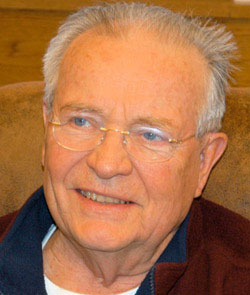 John Elliff
John Elliff
STERLING HEROES is a unique collection of first-person accounts of World War II service.
Thirty-six men from Sterling and surrounding Logan County in rural northeastern Colorado shared their very personal experiences in video-recorded interviews conducted by Dr. John Elliff, a Sterling ophthalmologist now retired, beginning in 2000. Dr. Elliff’s project spanned more than 10 years.
Dr. Elliff engaged veteran journalist and author Denny Dressman to edit transcripts of the interviews and produce a remarkable history of the period that touched the lives of all Americans.
The collection of veterans—all from “the land of the endless horizon,” as Dressman describes Sterling and Logan County—represent a remarkable microcosm of America during the war years of the early 1940s.
Some were in the Army, some in the Navy; others flew for the Air Corps, and some were Marines. They served in the European Theater, all across the Pacific, and even in the Aleutians. Some landed on Omaha Beach on the Normandy coast, fought in the Battle of the Bulge, or took part in the bloody invasion of Okinawa.
Some became prisoners of war—enduring deplorable conditions; one survived Pearl Harbor aboard the battleship Tennessee, anchored just in front of the USS Arizona, which took a direct hit and sank, killing 1,177 helpless sailors.
One man was a code-breaker; another was in the first unit to liberate the Dachau concentration camp; still another transmitted half of President Roosevelt’s last message to Japanese Emperor Hirohito just before the Pearl Harbor attack.
One was a bonafide Flying Ace. Another discovered that a physician who treated his sinus infection in Sterling—30 years later—provided the life-saving emergency treatment he received in a field hospital in Holland in 1944. Still another came to America as Italian soldier captured in North Africa, and became a U.S. citizen and 65-year resident of northeastern Colorado.
Poignant. Harrowing. Humorous. Remarkable. Each Sterling Hero’s story is unique, yet altogether they are representative of America’s wartime service experience from small towns to big cities, coast-to-coast.
STERLING HEROES chronicles a period in America’s history that citizens of all ages today need to know and appreciate.
View the Table of Contents and a sample chapter.
"Heroes" comes to life in audio recording
Sterling Heroes of World War II is now available through the Colorado Talking Book Library in audio form for those with conditions that prevent reading a book.
The Colorado Talking Book Library (CTBL) is part of a national network of libraries that partner with The Library of Congress unit known as the National Library Service for the Blind and Physically Handicapped to deliver services to the print-disabled. Bi-monthly catalogs inform the user community nationwide of new and previously existing titles that have been audio-recorded.
CTBL books and magazines are recorded in an audio format that requires special playback equipment. That equipment is loaned by participating libraries, and a user may keep it for as long as it is being actively used to listen to the recordings of published works. The audio recordings also are loaned, free of charge in the same way a conventional library loans titles.
Recipients of the CTBL listening devices and audio recordings must be certified by a medical doctor or doctor of osteopathy. Eligible individuals include those who are legally blind, seriously visually impaired, unable to handle books or turn pages, or who have a certified learning disability severe enough to prevent reading in the usual manner.
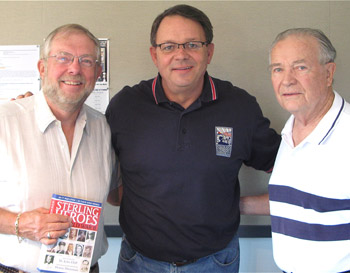 Rick Crandall of KEZW (center) with Denny Dressman (left) and Dr. John Elliff following their July 12 interview.
Rick Crandall of KEZW (center) with Denny Dressman (left) and Dr. John Elliff following their July 12 interview.
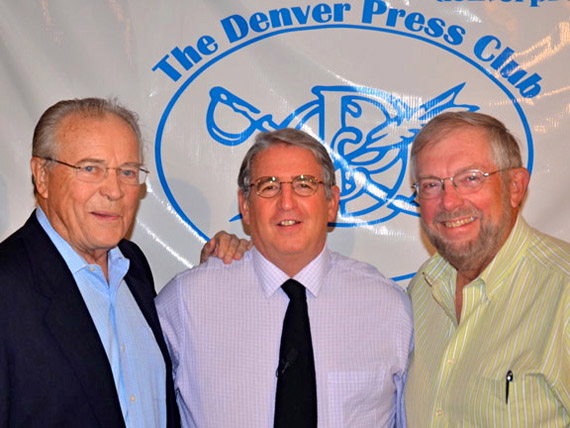 Denver Press Club president Bruce Goldberg welcomed Dr. Elliff and Denny Dressman at a Book Beat program, which was recorded for showing on Denver's Comcast Channel 8.
Denver Press Club president Bruce Goldberg welcomed Dr. Elliff and Denny Dressman at a Book Beat program, which was recorded for showing on Denver's Comcast Channel 8.
Julie Simpson
Colorado Country Life
Read Full Review
November, 2012 (Reprinted with permission)
A Japanese code breaker, an "ace" pilot, an indomitable prisoner of war, a death camp liberator, a fearless sailor, a B-17 bomber crew member and many, many more—all of them are residents of northeastern Colorado, all of them ordinary men who became extraordinary heroes.
World War II called American young men, boys really, to leave the safety of life in the United States for the gore and terror of the battlefield. In the Pacific, men worked around the clock under the threat of submarines, torpedoes and kamikaze fighters as they captured tiny island after island as strongholds for the U.S. Navy. In the European theater, artillerymen, bomber crews, pilots and infantrymen paid with their own blood for every mile inroad gained against the Nazis in France, North Africa, the Netherlands, Italy and, finally, Germany. In both hemispheres, Colorado soldiers and sailors fought and persevered.
They were injured, witnessed the deaths of their comrades and suffered hunger, cold and fear in the name of their country, and now they live in the Sterling area as average citizens. Their amazing stories of courage, honor and sheer luck are recorded in this extraordinarily valuable collection. A fitting and timeless memorial to their sacrifices, it is an assurance that their bravery will be remembered for many more generations to come.
Uncover this treasure of a book in local bookstores or online at comservbooks.com.
“It's like the little kid in class," says Dr. John Elliff of Sterling. "The teacher says, 'We are going to talk about Pearl Harbor.' And the little kid says, 'Who's Pearl Harbor?' That's why it's important. These things slip by us."
Jean Gray
The Haxtun-Fleming Herald and South Platte Sentinel
Read Full Review
By Jean Gray
Special to the Haxtun-Fleming Herald and South Platte Sentinel
Reprinted with permission
With an estimated 1,100 World War II veterans dying daily in the United States, telling their stories becomes critical to the preservation of that era, says Dr. John Elliff of Sterling. “It’s like the little kid in class. The teacher says, ‘We are going to talk about Pearl Harbor.’ And the little kid says, ‘Who’s Pearl Harbor?’ That’s why it’s important. These things slip by us.” People living in Northeast Colorado and a few in the Denver Metro area may recognize the name, Dr. John Elliff, either through his 50-plus years practicing Ophthalmology in Sterling or through his performances as a soloist jazz pianist or as a member of the Hoagies, a Denver-area jazz and swing-era music group. He splits his time between Denver and Sterling these days.
Others may recognize one or more names from the list of 36 veterans, all but one from Northeast Colorado, that Dr. Elliff enticed to tell their stories. Those stories, first video taped and later transcribed, wound their way through the capable editing of veteran journalist Denny Dressman and into a book titled Sterling Heroes of World War II, appropriately scheduled to launch on July 4, the date America celebrates the many freedoms these and other veterans risked their lives to preserve.
Dr. Elliff recorded the interviews over a 10-year period beginning in 2000, all but one of the men coming to him as patients. “They chose me,” he says, readily admitting that the 36 men, 17 of which have since passed away, represent a mere fraction of the number from Northeast Colorado who fought in WWII. “We sent thousands of guys from this part of the country,” he says, adding that he feels the group represents a profile of all who served. “These guys went everywhere. They did everything. They flew. They were in the Pacific. They were in Asia. They were in Europe. We got guys who were in the Navy. We got guys who were prisoners of war.
“Every one of these guys was absolutely sincere in their work. A lot had various adventures, but these guys were true patriots. They were upset about the Japanese attacking us (at Pearl Harbor on Dec. 7, 1941), so a lot of these guys volunteered when they were 17 and had to have their mothers sign for them to go into the service. A unique bunch of guys.” He says the first person narratives make the book unique. “That’s the difference in this book and most war stories. Most war stories are third person. Somebody is talking about it. This book, these guys are telling their own story.” Ten years into taping the interviews, he decided he wanted to put them in book form so he asked employee Lila Moore to transcribe them. Assistant Evelyn Harper says the project took a total of 13 years, first recording on VHF (very high frequency) tapes, and then later transferring to DVDs and then transcription. Once Moore transcribed the tapes, Dr. Elliff took the manuscript to Scott Johnson, a friend and fellow musician who runs Sputnik Design Works in Denver. Johnson suggested they ask Dressman to edit the transcript to a manageable size. “When I interviewed these guys, I tried to get their story from the service. What happened to them? How did it affect them? How did it affect their family? A lot of that’s not in the book. Denny just chopped it out.” He is considering a follow-up film or donating the tapes to a repository that holds similar archives.
Dressman, a 43-year veteran of the newspaper business and author of four books, read portions of the transcript before signing on. “I read a couple of the interviews from the transcript at random and realized how extraordinary they were,” he says. “I saw tremendous potential. My goal was to present them in the most effective way that would allow their unique first-person accounts to shine.
“From that goal, I came up with the idea of the third-person intros, and then realized that, in order to not disrupt the flow of the first-person accounts, something like the Historical References was needed to explain or elaborate on certain things they talked about.”
In his editor’s note at the end of the book, Dressman writes that it is one of the most unusual books in the vast array of Word War II literature published. “You should judge for yourself, but I am proud of the way it turned out. I think it provides a picture of America during the war years, and the experience of military service then, that is unique. It’s a real microcosm of the time in America, and all the more amazing because Dr. Elliff didn’t screen the 36 guys or try to select guys to represent the broad spectrum that he wound up with. These are 36 guys from the same area, who had all of these different experiences. Amazing!”
Each of the 36 stories begins with a reproduction of that veteran’s dog tag and ends with a current photo, something Dressman suggested, says Dr. Elliff. “Mr. Dressman said we needed pictures of all of these guys, so with the help of Mrs. Harper, we called and got the pictures from the families.” He says Harper has been good about “bird-dogging” those kinds of things.
Harper, who previously worked for Logan County Development and the Brush School District, says it was fun. “I was very honored to be involved in a project of such magnitude, and I enjoyed talking to the vets and their wives.”
Dr. Elliff, who was 13 in 1941, says he hopes the children and grandchildren of these 36 veterans read the book so they understand, not only what these men did, but also what the world was like at that time. “The United States was totally mobilized,” he says. “I mean everybody was mobilized. We had rationing. We had shoe rationing. We had gas rationing. We had clothing rationing. We had paper drives. We had rubber drives. We had scrap drives. Everybody was into it.”
Dressman says he hopes the book becomes one schools use to teach the WWII era in America and America in WWII.
He says a quote on the back of the book by Rick Crandall, president of the Colorado Freedom Memorial Foundation, sums up his thoughts on the importance of the book to Colorado. “Colorado has much to be proud of in these hometown heroes,” writes Crandall. “I never tire of reading about the feats of ordinary people in extraordinary times.”
An essay in the front of the book notes that, “without exception,” the men who told their stories said, “I am not a hero.” Dr. Elliff disagrees. “These guys represented 100 percent of the effort. Every one of them I called a hero. They risked their necks. Every one of them.”
Interview with Rick Crandall, KEZW-AM 1430, July 12, 2012
Channel 8 recording of Denver Press Club Book Beat presentation, July 30, 2012
Interview with Nia Hill on KSIR radio, Fort Morgan, January 14, 2013
Multiple reasons to celebrate in Sterling on July 4
In addition to the 236th anniversary of America's Declaration of Independence and the 125th birthday of Logan County, the annual July 4 celebration at the Overland Trail Museum and adjacent park in Sterling also marked the official publication launch of Sterling Heroes of World War II, a unique collection of personal experiences shared by 36 World War II veterans from northeastern Colorado.
Hundreds of residents of Sterling and surrounding towns lined up for copies signed by Dr. John Elliff, who originated the project by videorecording interviews with the men between 2000 and 2011, and co-author Denny Dressman. About a dozen of the "Heroes" attended the event, and some autographed their chapters for those who asked them to.

